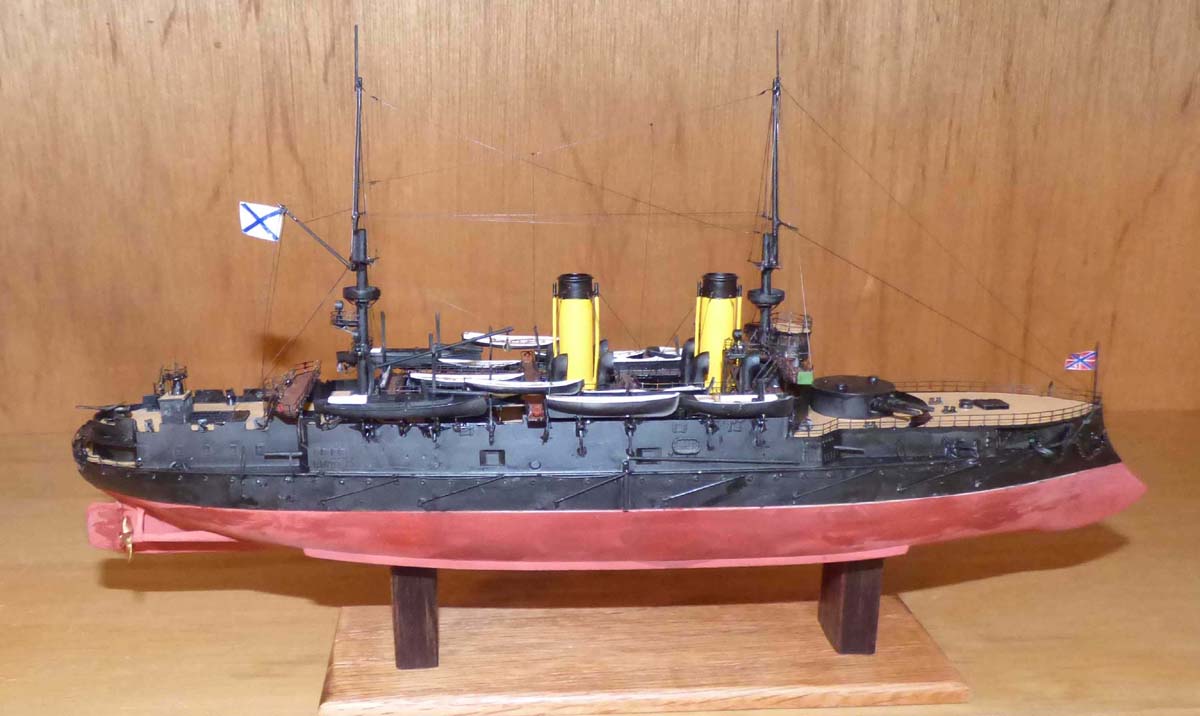
1/350 Imperator Nikolai I (Combrig)
|
by Robert Apfelzweig |

1/350 Imperator Nikolai I (Combrig)
Built for the Imperial Russian Navy’s Baltic fleet in the late 1880s, the Imperator Nikolai I was an odd-looking ship constructed at a time when many such battleships were odd-looking, at least insofar as the standard predreadnought warship was to appear in the early 20th century. She had a predreadnought’s standard twin 12-in. turret forward, but then the rear half of the ship looked, at least to me, as though it were from a sailing ship-of-the-line from the 1850s or so. Completed in 1892, the ship’s two 12-in. guns were supplemented with a secondary armament of four casemated 9-in. and eight casemated 6-in. guns, all of a 30 – 35 caliber design from 1877 that incorporated up to seven sleeves on the breech end of each barrel. Their rate of fire, particularly the 12-in. guns, was rather slow, so that the ship was soon obsolete, although the 6-in. guns may have been replaced with newer, more quick-firing weapons prior to the Russo-Japanese War of 1904-05. This last matter is somewhat confusing, as Combrig’s otherwise excellent model, which seems to portray the ship in its 1904 appearance, has only a single 1877 6-in. gun at the fantail, with a splinter shield, and the eight casemates for the other 6-in. guns seem to be either shut or plated over. Also, an upper deck aft of the mainmast was removed in 1898, and so this more reduced superstructure is what the model includes. The kit has a large, robust photoetch fret, which seems to be copper rather than brass, and the ladders, while very sturdy, appear to have overly large and widely spaced steps. Combrig’s kit is a Box 261 issue, so it includes railings, although not quite enough (I had to supplement with about four inches’ worth from my spare parts stash) and they have no bottom rail, so that the individual stanchions must be glued to the decks (about every third one has an added piece at the bottom that can be bent to provide an additional attachment surface). Fit of the upper and lower hulls was excellent.The multi-page assembly instructions for this kit are the best I have ever seen from Combrig, with very clean illustrations that, for once, clearly show not only where each part goes, but often how it appears (and from several angles) once installed. The photoetch parts are all numbered on the fret, and though the resin parts are numbered, and individually illustrated in the instructions, most are not numbered on their respected resin blocks, though this is not really a problem. As is typical with Combrig, the instructions specify the dimensions of plastic or brass rods that must be supplied by the modeler for the upper masts and yardarms (I used Master-Model parts for these), but at least Combrig includes the thick lower masts, boat and boarding booms. There are no painting schemes for the ship, but online photos consistently show a black hull and I have elected to show the ship all in black; my basis for this and for the rigging is the excellent build of this kit shown earlier on this site by Vadim Popov. One last comment about this kit – I have noticed this on the last several such Combrig resin models I have built, which is that several photoetch parts, despite being shown in the assembly instructions, are missing from the photoetch set. In this case, it was only two (of eight) small, roughly square, splinter shields for some 47 mm guns, which I was easily able to scratch-build.
The combat history of the Imperator Nikolai I was not impressive. Slightly damaged during the Tsushima battle and too slow to escape, she surrendered to Admiral Togo’s fleet the next day and was repaired and incorporated into the Japanese Navy as the training/coast defense ship Iki, and then sunk as a target in 1915.
